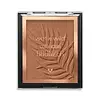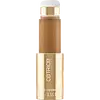What's inside
What's inside
 Key Ingredients
Key Ingredients

 Benefits
Benefits

 Concerns
Concerns

 Ingredients Side-by-side
Ingredients Side-by-side

Caprylic/Capric Triglyceride
MaskingSynthetic Fluorphlogopite
Boron Nitride
AbsorbentMicrocrystalline Cellulose
AbsorbentSilica
AbrasiveDimethicone
EmollientMagnesium Myristate
Dimethicone/Vinyl Dimethicone Crosspolymer
Skin ConditioningPhenoxyethanol
PreservativeLauroyl Lysine
Skin ConditioningCaprylyl Glycol
EmollientEthylhexylglycerin
Skin ConditioningHexylene Glycol
EmulsifyingTin Oxide
AbrasiveWater
Skin ConditioningO-Cymen-5-Ol
AntimicrobialTriethoxycaprylylsilane
Iron Oxides
CI 77492
Cosmetic ColorantCI 77499
Cosmetic ColorantMica
Cosmetic ColorantTitanium Dioxide
Cosmetic ColorantCaprylic/Capric Triglyceride, Synthetic Fluorphlogopite, Boron Nitride, Microcrystalline Cellulose, Silica, Dimethicone, Magnesium Myristate, Dimethicone/Vinyl Dimethicone Crosspolymer, Phenoxyethanol, Lauroyl Lysine, Caprylyl Glycol, Ethylhexylglycerin, Hexylene Glycol, Tin Oxide, Water, O-Cymen-5-Ol, Triethoxycaprylylsilane, Iron Oxides, CI 77492, CI 77499, Mica, Titanium Dioxide
Water
Skin ConditioningDimethicone
EmollientGlycerin
HumectantPolymethylsilsesquioxane
Butylene Glycol
HumectantPEG-10 Dimethicone
Skin ConditioningLauryl PEG-9 Polydimethylsiloxyethyl Dimethicone
Skin ConditioningIsododecane
EmollientEthylhexyl Polyhydroxystearate
EmollientSodium Chloride
MaskingMagnesium Stearate
Cosmetic ColorantTocopheryl Acetate
AntioxidantSodium Hyaluronate
HumectantTocopherol
AntioxidantDimethicone Crosspolymer
Emulsion StabilisingQuaternium-18 Bentonite
Propylene Carbonate
SolventTriethoxycaprylylsilane
Squalane
EmollientEthylhexylglycerin
Skin ConditioningAlumina
AbrasivePhenoxyethanol
PreservativeCI 77491
Cosmetic ColorantCI 77492
Cosmetic ColorantCI 77499
Cosmetic ColorantCI 77891
Cosmetic ColorantWater, Dimethicone, Glycerin, Polymethylsilsesquioxane, Butylene Glycol, PEG-10 Dimethicone, Lauryl PEG-9 Polydimethylsiloxyethyl Dimethicone, Isododecane, Ethylhexyl Polyhydroxystearate, Sodium Chloride, Magnesium Stearate, Tocopheryl Acetate, Sodium Hyaluronate, Tocopherol, Dimethicone Crosspolymer, Quaternium-18 Bentonite, Propylene Carbonate, Triethoxycaprylylsilane, Squalane, Ethylhexylglycerin, Alumina, Phenoxyethanol, CI 77491, CI 77492, CI 77499, CI 77891
 Reviews
Reviews

Ingredients Explained
These ingredients are found in both products.
Ingredients higher up in an ingredient list are typically present in a larger amount.
Ci 77492 is also hydrated iron III oxide. It's sole purpose is to give a yellow hue to products.
Iron III oxides are classified as inorganic chemicals for coloring.
Synthetically created Ci 77492 is considered safer than those naturally found. This is because the synthetically created version may contain less impurities. Iron oxides are generally non-toxic and non-allergenic.
Learn more about CI 77492Ci 77499 is also hydrated iron III oxide. It is created from mixing red and black iron oxides. This helps give shades of darkness to a product.
Iron III oxides are classified as inorganic chemicals for coloring.
Dimethicone is a type of synthetic silicone created from natural materials such as quartz.
What it does:
Dimethicone comes in different viscosities:
Depending on the viscosity, dimethicone has different properties.
Ingredients lists don't always show which type is used, so we recommend reaching out to the brand if you have questions about the viscosity.
This ingredient is unlikely to cause irritation because it does not get absorbed into skin. However, people with silicone allergies should be careful about using this ingredient.
Note: Dimethicone may contribute to pilling. This is because it is not oil or water soluble, so pilling may occur when layered with products. When mixed with heavy oils in a formula, the outcome is also quite greasy.
Learn more about DimethiconeEthylhexylglycerin (we can't pronounce this either) is commonly used as a preservative and skin softener. It is derived from glyceryl.
You might see Ethylhexylglycerin often paired with other preservatives such as phenoxyethanol. Ethylhexylglycerin has been found to increase the effectiveness of these other preservatives.
Phenoxyethanol is a preservative that has germicide, antimicrobial, and aromatic properties. Studies show that phenoxyethanol can prevent microbial growth. By itself, it has a scent that is similar to that of a rose.
It's often used in formulations along with Caprylyl Glycol to preserve the shelf life of products.
Triethoxycaprylylsilane is a silicone used to bind and stabilize ingredients.
As an emulsifier, it helps prevent ingredients from separating. This can help elongate the shelf life of products.
Triethoxycaprylylsilane is often used to coat mineral sunscreens ingredients to help give a better feel. It also helps reduce oxidative stress in sunscreens.
Learn more about TriethoxycaprylylsilaneWater. It's the most common cosmetic ingredient of all. You'll usually see it at the top of ingredient lists, meaning that it makes up the largest part of the product.
So why is it so popular? Water most often acts as a solvent - this means that it helps dissolve other ingredients into the formulation.
You'll also recognize water as that liquid we all need to stay alive. If you see this, drink a glass of water. Stay hydrated!
Learn more about Water